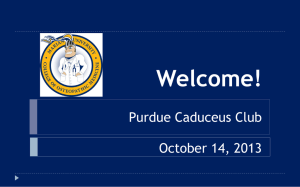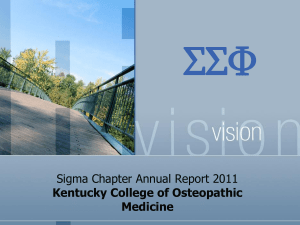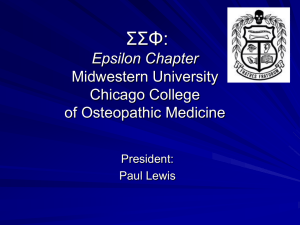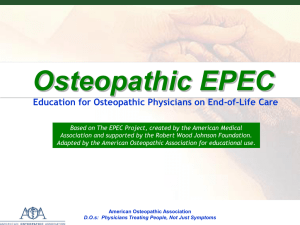Osteopathic EPEC Module 2 - American Osteopathic Association
advertisement
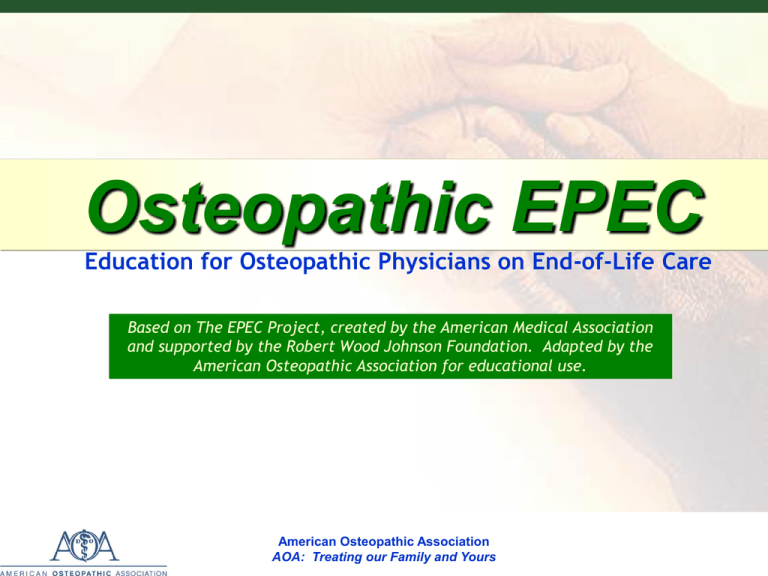
E P E C Osteopathic EPEC Education for Osteopathic Physicians on End-of-Life Care Based on The EPEC Project, created by the American Medical Association and supported by the Robert Wood Johnson Foundation. Adapted by the American Osteopathic Association for educational use. American Osteopathic Association American Osteopathic Association D.O.s: AOA: Physicians Treating People, Not Just Symptoms Treating our Family and Yours E P E C Module 2 Communicating “Uncomfortable” Information American Osteopathic Association D.O.s: Physicians Treating People, Not Just Symptoms E P E C Objectives • Know why communication of “uncomfortable news” is important • Understand the 7-step protocol for delivering bad news • Know what to do at each step American Osteopathic Association D.O.s: Physicians Treating People, Not Just Symptoms E P E C Importance • Most people want to know • Strengthens physician-patient relationship • Fosters collaboration • Permits patients, families to plan, cope American Osteopathic Association D.O.s: Physicians Treating People, Not Just Symptoms E P E C 7-step protocol . . . 1. Know yourself 2. Create a plan 3. What does the patient know? 4. How much does the patient want to know? Adapted from Robert Buckman American Osteopathic Association D.O.s: Physicians Treating People, Not Just Symptoms E P E C . . . 7-step protocol 5. Sharing the information 6. Responding to patient, family feelings 7. Planning and follow-up Adapted from Robert Buckman American Osteopathic Association D.O.s: Physicians Treating People, Not Just Symptoms E P E C Step 1: Know Yourself • Physicians communicate their own emotional responses • Be aware of your own responses • Process your feelings with others American Osteopathic Association D.O.s: Physicians Treating People, Not Just Symptoms E P E C Step 2: Create a Plan • Allot adequate time • • Determine who else the patient would like present • • • Prevent interruptions If child, patient’s parents Plan what you will say • Confirm medical facts • Don’t delegate Create a conducive environment American Osteopathic Association D.O.s: Physicians Treating People, Not Just Symptoms E P E C Step 3: What does the patient know? • Establish what the patient knows • Child’s parents • Assess ability to comprehend new bad news • Reschedule if unprepared American Osteopathic Association D.O.s: Physicians Treating People, Not Just Symptoms E P E C Step 4: How much does the patient want to know? . . . • Recognize, support various patient preferences • Decline voluntarily to receive information • Designate someone to communicate on his or her behalf American Osteopathic Association D.O.s: Physicians Treating People, Not Just Symptoms E P E C . . . Step 4: How much does the patient want to know? • People handle information differently • Race, ethnicity, culture, religion, socioeconomic status • Age and developmental level American Osteopathic Association D.O.s: Physicians Treating People, Not Just Symptoms E P E C Advance preparation • Initial assessment • Preparation for critical tests • What does the patient know? (step 2) • How does the patient handle information? (step 3) American Osteopathic Association D.O.s: Physicians Treating People, Not Just Symptoms E P E C When family says “don’t tell” . . . • Legal obligation to obtain informed consent from the patient • Promote congenial family alliance • Honesty with a child promotes trust American Osteopathic Association D.O.s: Physicians Treating People, Not Just Symptoms E P E C . . . When family says “don’t tell” • Ask the family: • Why not tell? • What are you afraid I will say? • What are your previous experiences? • Is there a personal, cultural, or religious context? • Talk to the patient together American Osteopathic Association D.O.s: Physicians Treating People, Not Just Symptoms E P E C Step 5: Sharing the information . . . • Say it, then stop • Avoid monologue, promote dialogue • Avoid jargon, euphemisms • Pause frequently • Check for understanding • Use silence, body language American Osteopathic Association D.O.s: Physicians Treating People, Not Just Symptoms E P E C . . . Step 5: Sharing the information • Don’t minimize severity • Avoid vagueness, confusion • Implications of “I’m sorry” American Osteopathic Association D.O.s: Physicians Treating People, Not Just Symptoms E P E C Step 6: Responding to feelings . . . • Affective response • • Cognitive response • • Tears, anger, sadness, love, anxiety, relief, other Denial, blame, guilt, disbelief, fear, loss, shame, intellectualization Basic psychophysiologic response • Fight-flight American Osteopathic Association D.O.s: Physicians Treating People, Not Just Symptoms E P E C Step 6: Responding to feelings . . . • Be prepared for • Outburst of strong emotion • Broad range of reactions • Give time to react American Osteopathic Association D.O.s: Physicians Treating People, Not Just Symptoms E P E C . . . Step 6: Responding to feelings • Listen quietly, attentively • Encourage descriptions of feelings • Use nonverbal communication American Osteopathic Association D.O.s: Physicians Treating People, Not Just Symptoms E P E C Step 7: Planning, follow-up . . . • Plan for the next steps • Additional information, tests • Treat symptoms, referrals as needed • Discuss potential sources of support American Osteopathic Association D.O.s: Physicians Treating People, Not Just Symptoms E P E C . . . Step 7: Planning, follow-up • Give contact information, set next appointment • Before leaving, assess: • Safety of the patient • Supports at home • Repeat news at future visits American Osteopathic Association D.O.s: Physicians Treating People, Not Just Symptoms E P E C When language is a barrier . . . • Use a skilled professional translator • Familiar with medical terminology • Comfortable translating bad news • Consider telephone translation services American Osteopathic Association D.O.s: Physicians Treating People, Not Just Symptoms E P E C . . . When language is a barrier • Avoid family as primary translators • Confuses family members • Difficulty translating medical concepts • May modify news to protect patient • May supplement the translation • Speak directly to the patient American Osteopathic Association D.O.s: Physicians Treating People, Not Just Symptoms E P E C Communicating prognosis . . . • Some patients want to plan • Others are seeking reassurance American Osteopathic Association D.O.s: Physicians Treating People, Not Just Symptoms E P E C Communicating prognosis . . . • Inquire about reasons for asking • “What are you expecting to happen?” • “How specific do you want me to be?” • “What experiences have you had with: - others with same illness? others who have died?” American Osteopathic Association D.O.s: Physicians Treating People, Not Just Symptoms E P E C Communicating prognosis . . . • Patients vary • “Planners” want more details • Those seeking reassurance want less • Avoid precise answers • Hours to days … months to years • Average American Osteopathic Association D.O.s: Physicians Treating People, Not Just Symptoms E P E C . . .Communicating prognosis • Limits of prediction • Hope for the best, plan for the worst • Better sense over time • Can’t predict surprises, get affairs in order • Reassure availability, whatever happens American Osteopathic Association D.O.s: Physicians Treating People, Not Just Symptoms E P E C Communicating “Uncomfortable” Information Summary American Osteopathic Association D.O.s: Physicians Treating People, Not Just Symptoms
